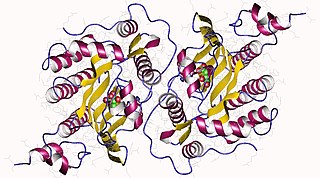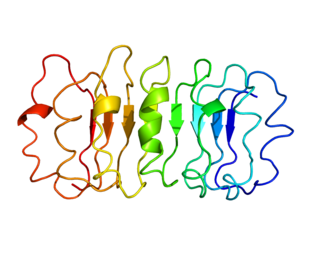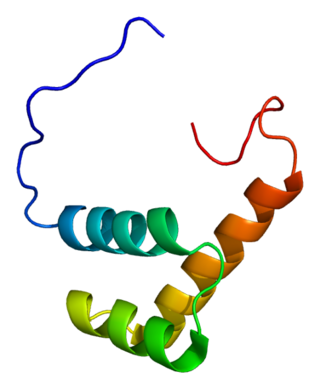Endothelin receptor type B, also known as ETB is a protein that in humans is encoded by the EDNRB gene. [5]
Endothelin receptor type B, also known as ETB is a protein that in humans is encoded by the EDNRB gene. [5]
Endothelin receptor type B is a G protein-coupled receptor which activates a phosphatidylinositol-calcium second messenger system. Its ligand, endothelin, consists of a family of three potent vasoactive peptides: ET1, ET2, and ET3. A splice variant, named SVR, has been described; the sequence of the ETB-SVR receptor is identical to ETRB except for the intracellular C-terminal domain. While both splice variants bind ET1, they exhibit different responses upon binding which suggests that they may be functionally distinct. [6]
In melanocytic cells the EDNRB gene is regulated by the microphthalmia-associated transcription factor. Mutations in either gene are links to Waardenburg syndrome. [7] [8]
The multigenic disorder, Hirschsprung disease type 2, is due to mutation in endothelin receptor type B gene. [9]
In horses, a mutation in the middle of the EDNRB gene, Ile118Lys, when homozygous, causes Lethal White Syndrome. [10] In this mutation, a mismatch in the DNA replication causes lysine to be made instead of isoleucine. [10] The resulting EDNRB protein is unable to fulfill its role in the development of the embryo, limiting the migration of the melanocyte and enteric neuron precursors. A single copy of the EDNRB mutation, the heterozygous state, produces an identifiable and completely benign spotted coat color called frame overo. [11]
Endothelin receptor type B has been shown to interact with Caveolin 1. [12]

Waardenburg syndrome is a group of rare genetic conditions characterised by at least some degree of congenital hearing loss and pigmentation deficiencies, which can include bright blue eyes, a white forelock or patches of light skin. These basic features constitute type 2 of the condition; in type 1, there is also a wider gap between the inner corners of the eyes called telecanthus, or dystopia canthorum. In type 3, which is rare, the arms and hands are also malformed, with permanent finger contractures or fused fingers, while in type 4, the person also has Hirschsprung's disease. There also exist at least two types that can result in central nervous system (CNS) symptoms such as developmental delay and muscle tone abnormalities.

Lethal white syndrome (LWS), also called overo lethal white syndrome (OLWS), lethal white overo (LWO), and overo lethal white foal syndrome (OLWFS), is an autosomal genetic disorder most prevalent in the American Paint Horse. Affected foals are born after the full 11-month gestation and externally appear normal, though they have all-white or nearly all-white coats and blue eyes. However, internally, these foals have a nonfunctioning colon. Within a few hours, signs of colic appear; affected foals die within a few days. Because the death is often painful, such foals are often humanely euthanized once identified. The disease is particularly devastating because foals are born seemingly healthy after being carried to full term.

Endothelins are peptides with receptors and effects in many body organs. Endothelin constricts blood vessels and raises blood pressure. The endothelins are normally kept in balance by other mechanisms, but when overexpressed, they contribute to high blood pressure (hypertension), heart disease, and potentially other diseases.
Albinism-black lock-cell migration disorder is the initialism for the following terms and concepts that describe a condition affecting a person's physical appearance and physiology: (1) A – albinism, (2) B – black lock of hair, (3) C – cell migration disorder of the neurocytes of the gut, and (4) D – sensorineural deafness. The syndrome is caused by mutation in the endothelin B receptor gene (EDNRB).

Vasopressin receptor 2 (V2R), or arginine vasopressin receptor 2, is a protein that acts as receptor for vasopressin. AVPR2 belongs to the subfamily of G-protein-coupled receptors. Its activity is mediated by the Gs type of G proteins, which stimulate adenylate cyclase.

Coproporphyrinogen-III oxidase, mitochondrial is an enzyme that in humans is encoded by the CPOX gene. A genetic defect in the enzyme results in a reduced production of heme in animals. The medical condition associated with this enzyme defect is called hereditary coproporphyria.
There are at least four known endothelin receptors, ETA, ETB1, ETB2 and ETC, all of which are G protein-coupled receptors whose activation result in elevation of intracellular-free calcium, which constricts the smooth muscles of the blood vessels, raising blood pressure, or relaxes the smooth muscles of the blood vessels, lowering blood pressure, among other functions.

The thyrotropin receptor is a receptor that responds to thyroid-stimulating hormone and stimulates the production of thyroxine (T4) and triiodothyronine (T3). The TSH receptor is a member of the G protein-coupled receptor superfamily of integral membrane proteins and is coupled to the Gs protein.

Iduronate 2-sulfatase is a sulfatase enzyme associated with Hunter syndrome. It catalyses hydrolysis of the 2-sulfate groups of the L-iduronate 2-sulfate units of dermatan sulfate, heparan sulfate and heparin.

The RETproto-oncogene encodes a receptor tyrosine kinase for members of the glial cell line-derived neurotrophic factor (GDNF) family of extracellular signalling molecules. RET loss of function mutations are associated with the development of Hirschsprung's disease, while gain of function mutations are associated with the development of various types of human cancer, including medullary thyroid carcinoma, multiple endocrine neoplasias type 2A and 2B, pheochromocytoma and parathyroid hyperplasia.

Zinc finger E-box-binding homeobox 2 is a protein that in humans is encoded by the ZEB2 gene. The ZEB2 protein is a transcription factor that plays a role in the transforming growth factor β (TGFβ) signaling pathways that are essential during early fetal development.

The calcium-sensing receptor (CaSR) is a Class C G-protein coupled receptor which senses extracellular levels of calcium ions. It is primarily expressed in the parathyroid gland, the renal tubules of the kidney and the brain. In the parathyroid gland, it controls calcium homeostasis by regulating the release of parathyroid hormone (PTH). In the kidney it has an inhibitory effect on the reabsorption of calcium, potassium, sodium, and water depending on which segment of the tubule is being activated.

Galactosidase, beta 1, also known as GLB1, is a protein which in humans is encoded by the GLB1 gene.

Endothelin receptor type A, also known as ETA, is a human G protein-coupled receptor.

Endothelin converting enzyme 1, also known as ECE1, is an enzyme which in humans is encoded by the ECE1 gene.

Endothelin-3 is a protein that in humans is encoded by the EDN3 gene.

Transcription factor SOX-10 is a protein that in humans is encoded by the SOX10 gene.

Endothelin 2 (ET-2) is a protein encoded by the EDN2 gene in humans. It was first discovered in 1988 by Yanagisawa and team and belongs to a family of three endothelin peptide isoforms, which constrict blood vessels. ET-2 is encoded by genes on separate chromosomes to its isoforms and is mainly produced in vascular endothelial cells of the kidney, placenta, uterus, heart, central nervous system and intestine. It becomes present in the blood of animals and humans at levels ranging from 0.3pg/ml to 3pg/ml. ET-2 acts by binding to two different G-protein coupled receptors (GPCRs), the endothelin A receptor (EDNRA) and the endothelin B receptor (EDNRB).
Waardenburg Syndrome Type 4A is an extremely rare congenital disorder caused by a mutation in an endothelin receptor gene. It results in common Waardenburg syndrome symptoms such as abnormal hair and skin pigmentation and heterochromia, but also present with symptoms of Hirschsprung’s disease. Symptoms include abdominal pain and bowel obstruction. Waardenburg Syndrome Type 4A is the rarest among the types, appearing only once in about every 1,000,000 individuals. There have only been a total of 50 cases reported in total as of 2016.

Masashi Yanagisawa is a Japanese molecular biologist and physician, famous for his discovery of the hormone endothelin and the neuropeptide orexin, the absence of which is the cause of narcolepsy. He is currently the Director of the International Institute for Integrative Sleep Medicine, University of Tsukuba, and an adjunct professor at the Department of Molecular genetics, University of Texas Southwestern Medical Center.
AG mutation, which changed isoleucine to lysine in the predicted first transmembrane domain of the EDNRB protein. This was associated with LWFS when homozygous and with the overo phenotype when heterozygous. -->
This article incorporates text from the United States National Library of Medicine, which is in the public domain.